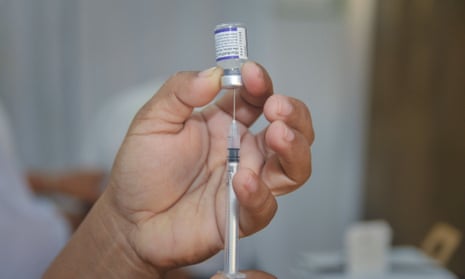Scientists have urged eligible people to have Covid booster shots after a major survey in England found evidence of “breakthrough infections” more than three months after full vaccination.
Researchers at Imperial College London analysed more than 100,000 swabs from a random sample of the population and found that Covid infection rates were three to four times higher among unvaccinated people than those who had received two shots.
But while full vaccination drove infection rates down substantially, from 1.76% in the unvaccinated to 0.35% in the three months after the second dose, infection rates rose again to 0.55% three to six months after the second shot.
The finding suggests that protection against infection, with or without symptoms, starts to wane several months after full vaccination, though other studies show that vaccine protection against hospitalisation and death is far more robust.
“The possible increase of breakthrough infections over time reinforces the need for a booster programme,” said Paul Elliott, head of the React study and professor in epidemiology and public health medicine at Imperial. “It’s an incentive for people to get their booster dose when it becomes available to them,” added Prof Christl Donnelly, a statistical epidemiologist on the study. The results came as new Covid cases in the UK rose to 42,776, the highest recorded since late July.
The React study has used community testing to provide regular snapshots of the epidemic in England throughout the Covid crisis. The latest data include results from 100,527 swabs provided between 9 and 27 September, and another 98,233 swabs taken in June and July.
All of the viruses sequenced in the study were the highly-transmissible Delta variant, with one sample carrying a mutation called E484K which may help the virus evade immunity from past infection or vaccination. The relative of Delta is being monitored by the UK Health Security Agency.
Preliminary results from the survey, which are not yet peer-reviewed, show that the highest rates of infection in September were among five to 17-year-olds, with about 2.5% testing positive, followed by 35 to 54-year-olds, the age group most likely to have children at school. Efforts to vaccinate healthy 12 to 15-year-olds and provide boosters for those aged 50 and above are now under way.
According to the study full vaccination reduced the risk of infection, with or without symptoms, by about 60%. The Pfizer vaccine appeared to be more effective than AstraZeneca’s, but the vaccines were given to different age groups at different points in the epidemic, so they cannot be directly compared.
While previous studies have shown that antibodies against Covid decline in the months after vaccination, recent work suggests that two doses are highly protective against severe disease. Last week, US researchers reported that two shots of Pfizer vaccine were 90% protective against hospitalisation for at least six months, even though protection against infection halved over the same period.
The React survey shows that while infection rates for England were broadly flat in September, the overall picture masked distinct trends in particular age groups and regions. Infections were rising sharply in school children, with the R number at 1.18 in those aged up to 17 years old. Rates were generally falling in those aged 18 to 54 and steady in those aged 55 and over.
Though R, the number of people an infected person typically passes the virus on to, stood at 1.03 for England as a whole in September, infections appeared to be rising in the East Midlands and London, with R at 1.36 and 1.59, the survey found. The infection rate was nearly twice as high in black participants than white (1.41% versus 0.78%), and more common in those in larger households, and among people who shared their home with at least one child.
